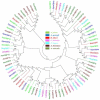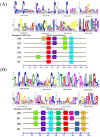Identification and expression profile analysis of odorant binding protein and chemosensory protein genes in Bemisia tabaci MED by head transcriptome
- PMID: 28166541
- PMCID: PMC5293548
- DOI: 10.1371/journal.pone.0171739
Identification and expression profile analysis of odorant binding protein and chemosensory protein genes in Bemisia tabaci MED by head transcriptome
Abstract
Odorant binding proteins (OBPs) and chemosensory proteins (CSPs) of arthropods are thought to be involved in chemical recognition which regulates pivotal behaviors including host choice, copulation and reproduction. In insects, OBPs and CSPs located mainly in the antenna but they have not been systematically characterized yet in Bemisia tabaci which is a cryptic species complex and could damage more than 600 plant species. In this study, among the 106,893 transcripts in the head assembly, 8 OBPs and 13 CSPs were identified in B. tabaci MED based on head transcriptomes of adults. Phylogenetic analyses were conducted to investigate the relationships of B. tabaci OBPs and CSPs with those from several other important Hemipteran species, and the motif-patterns between Hemiptera OBPs and CSPs were also compared by MEME. The expression profiles of the OBP and CSP genes in different tissues of B. tabaci MED adults were analyzed by real-time qPCR. Seven out of the 8 OBPs found in B. tabaci MED were highly expressed in the head. Conversely, only 4 CSPs were enriched in the head, while the other nine CSPs were specifically expressed in other tissues. Our findings pave the way for future research on chemical recognition of B. tabaci at the molecular level.
Conflict of interest statement
The authors have declared that no competing interests exist.
Figures








Similar articles
-
Genome-wide analysis of odorant-binding proteins and chemosensory proteins in the sweet potato whitefly, Bemisia tabaci.Insect Sci. 2019 Aug;26(4):620-634. doi: 10.1111/1744-7917.12576. Epub 2018 Mar 26. Insect Sci. 2019. PMID: 29441682 Free PMC article.
-
Candidate genes coding for odorant binding proteins and chemosensory proteins identified from dissected antennae and mouthparts of the southern green stink bug Nezara viridula.Comp Biochem Physiol Part D Genomics Proteomics. 2019 Sep;31:100594. doi: 10.1016/j.cbd.2019.100594. Epub 2019 May 11. Comp Biochem Physiol Part D Genomics Proteomics. 2019. PMID: 31170686
-
Variations in the expression of odorant binding and chemosensory proteins in the developmental stages of whitefly Bemisia tabaci Asia II-1.Sci Rep. 2024 Jul 1;14(1):15046. doi: 10.1038/s41598-024-65785-9. Sci Rep. 2024. PMID: 38951601 Free PMC article.
-
Beyond chemoreception: diverse tasks of soluble olfactory proteins in insects.Biol Rev Camb Philos Soc. 2018 Feb;93(1):184-200. doi: 10.1111/brv.12339. Epub 2017 May 7. Biol Rev Camb Philos Soc. 2018. PMID: 28480618 Review.
-
Comprehensive History of CSP Genes: Evolution, Phylogenetic Distribution and Functions.Genes (Basel). 2020 Apr 10;11(4):413. doi: 10.3390/genes11040413. Genes (Basel). 2020. PMID: 32290210 Free PMC article. Review.
Cited by
-
Antennal Transcriptome Analysis and Identification of Olfactory Genes in Glenea cantor Fabricius (Cerambycidae: Lamiinae).Insects. 2022 Jun 17;13(6):553. doi: 10.3390/insects13060553. Insects. 2022. PMID: 35735890 Free PMC article.
-
Decoding the genomic terrain: functional insights into 14 chemosensory proteins in whitefly Bemisia tabaci Asia II-1.Sci Rep. 2024 Nov 1;14(1):26252. doi: 10.1038/s41598-024-77998-z. Sci Rep. 2024. PMID: 39482332 Free PMC article.
-
Odorant Receptors and Odorant-Binding Proteins as Insect Pest Control Targets: A Comparative Analysis.Front Physiol. 2018 Aug 24;9:1163. doi: 10.3389/fphys.2018.01163. eCollection 2018. Front Physiol. 2018. PMID: 30197600 Free PMC article. Review.
-
Integrative transcriptomic and genomic analysis of odorant binding proteins and chemosensory proteins in aphids.Insect Mol Biol. 2019 Feb;28(1):1-22. doi: 10.1111/imb.12513. Epub 2018 Oct 5. Insect Mol Biol. 2019. PMID: 29888835 Free PMC article.
-
Apoptotic neurodegeneration in whitefly promotes the spread of TYLCV.Elife. 2020 Jul 30;9:e56168. doi: 10.7554/eLife.56168. Elife. 2020. PMID: 32729829 Free PMC article.
References
MeSH terms
Substances
LinkOut - more resources
Full Text Sources
Other Literature Sources

